Nick Baldwin spotlights some of the classic, larger dumptrucks that worked so hard in Great Britain back in the day.
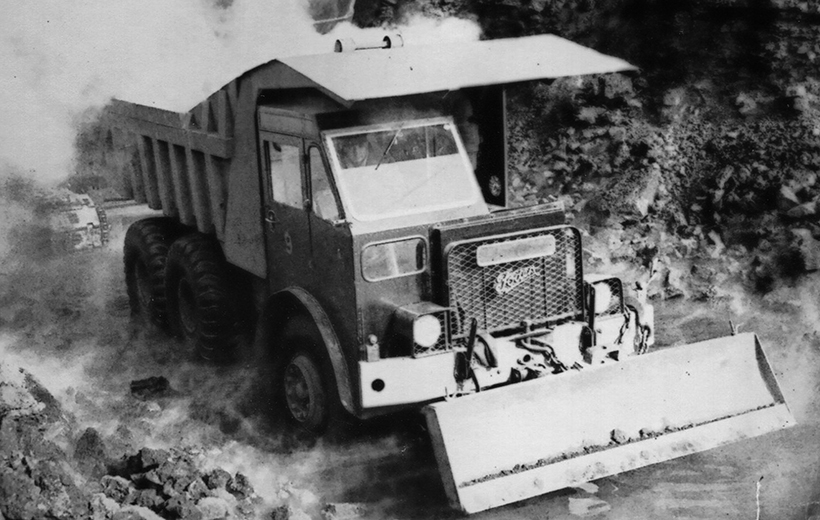
Foden had pioneered purpose-built British dumptrucks with its heavy duty six-wheelers in the late 1940s. In fact, Foden’s first 1947 prototype had been a four-wheel shuttle dumper, but in production it stuck with what it knew best and was soon supplying the Steel Company of Wales, and then quarries up and down the country, and soon as far afield as Italy and the Antipodes.
In the mid-1950s it was to decide to take on the successful British Euclid with entirely off-road oversize types. As noted in our recent survey of the AEC Dumptruk, the American firm had set up shop at Newhouse in Scotland in 1950 and had been snapped up by General Motors in the coronation year of 1953. Of course, General Motors owned Detroit Diesel whose two-strokes had proved ideal for earthmoving duties with Allis-Chalmers and others. Detroit-powered Euclids were a difficult act to follow but Foden was undaunted thanks to its own two-stroke diesels. Lots of its dumptrucks employed 150bhp Foden six-cylinder two-strokes with Foden’s own twelve speed gearbox and worm driven axles.

At the 1954 London Commercial Vehicle Show, Foden showed a twelve-cylinder 252bhp two-stroke which was essentially a pair of FD6 mounted side-by-side and running in opposite directions so that their crankshafts could run helical gearing that provided a single output shaft between them. The 8.18 litre engine was light at 2,500lb and produced 700lb ft of torque at 1,500 rpm. Quite what it was tried in first is unclear, but Foden had a wide choice of heavy tractive units and dumptrucks to choose from. A decision to make an all-out Euclid beater led to quarry trials of a prototype in 1957.
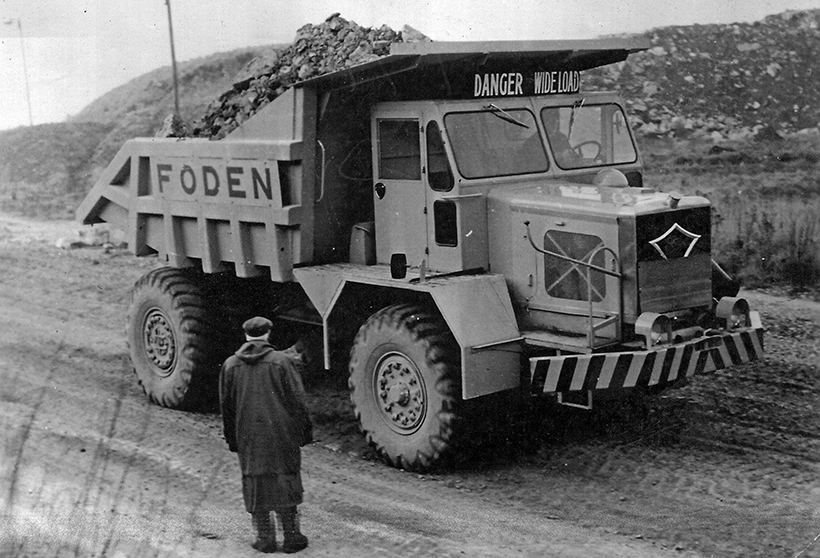
It seems that the Achilles heel was the complicated motor which was not quite powerful enough for the fifty-ton gross weight envisioned, and by the time that the FR 6/45 was launched at the end of 1957 (two years ahead of its AEC rival) it was fitted with a C6.TFL made by Rolls-Royce at its Sentinel-based Oil Engine Division. This six-cylinder 12.17 litre four-stroke diesel normally developed 210bhp at 2,100rpm and 547lb ft of torque, but was fitted with a Holset-Schwitzer turbocharger to increase the ratings to 300bhp and 840lb ft. A seventeen-inch Rochford clutch took the drive to a Twin Disc three-stage torque converter manufactured under licence by Rolls-Royce as its Hydro-Dynamic and thence to a Foden three-speed and reverse constant mesh box (said to be shared with the AEC Dumptruk) giving it a top speed of 24 mph.

The FR 6/45 had a Kirkstall 7.25 inch deep front axle and a spiral bevel reduction axle with secondary reduction at the hubs which was probably also by Kirkstall, as also used on the Dumptruk. Nominal gross weight of the Foden with its 18 cubic yard scow-end body was 46.5 tons and unladen weight 21.5 tons giving a 25 ton payload. Chassis rails were 18×6 inch rolled joists and there was leaf spring suspension at the front but not at the solid rear. Air brakes were augmented by a hand-operated disc transmission brake. Like the Euclid and AEC, there was left hand drive. It took eight seconds to tip the body to sixty-five degrees at which point the canopy projected 20 feet 2 inches skyward. At eleven feet wide and with a wheelbase of thirteen feet six inches the Foden was quite a monster with 18.00–25 Rock Lug tyres taller than the average operator.
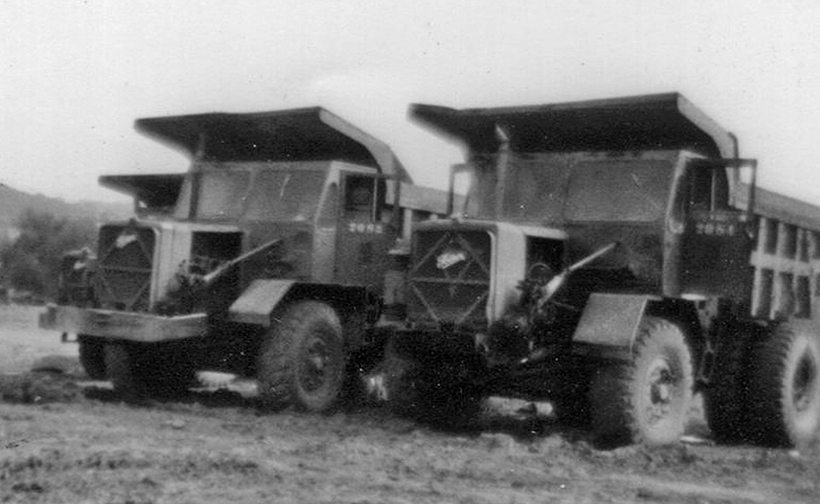
In my excitement when I learned about this new truck, I wrote from my boarding school to Foden to ask for more details. Working out that the firm would not cater for schoolboys, I typed the letter giving my family address. The result was a visit to my long-suffering mother from a salesman who failed to appreciate the educational benefits. My own nearest Foden contact came when its Brass Band visited the Malvern Winter Gardens near my school and I was given a special pass-out to hear it in action. I was thrilled to talk with some of the players afterwards and hear a bit about the factory where the FR 6/45 was made.
Fast forward to 2004 and the band was again in town. This time, when I went to find the players in the bar afterwards, I was told that none of them actually worked at Foden which by then had been absorbed into Leyland-DAF production and had abandoned dumptrucks long before.
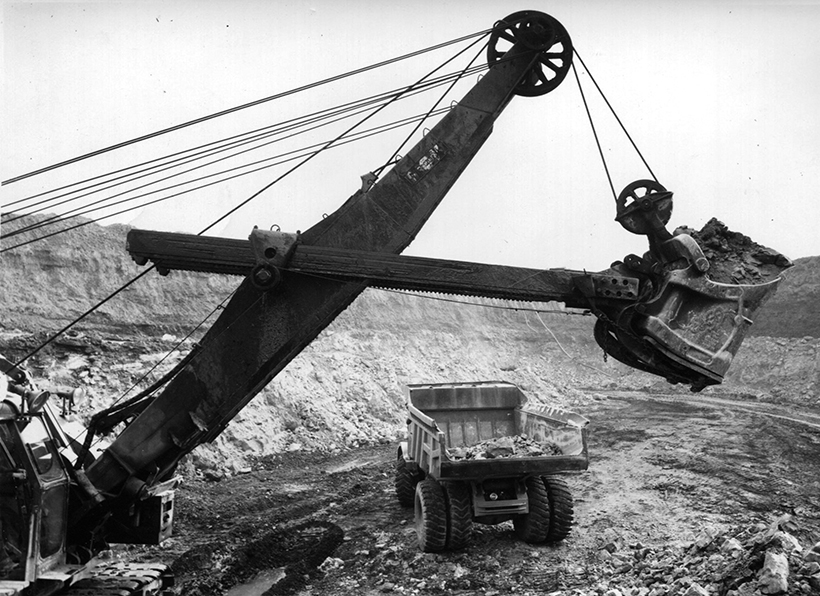
Back in the 1960s it wasn’t long before I met several FR 6/45s in action at a limestone quarry near Chipping Campden in the Cotswolds. Unfortunately, this was so deep that they appeared little more than noisy insects scurrying about. A subsequent meeting with three of them in the ironstone workings on Wroxton Heath near Banbury where they had replaced an internal railway was more rewarding, though the pictures I took with my Box Brownie were most disappointing.
As far as I can ascertain, the first general appearance of the Foden was in late 1958 at the Public Works Exhibition at Olympia in London before the days when practical demonstrations could be given at its 1960s Crystal Palace location. With a payload by then quoted at 28 tons, it was said by Commercial Motor to be the largest on display, which it certainly was in terms of the 6×4 Thornycroft Big Ben and AEC Dumptruk, as well as Scammell 4×4 Mountaineer and tiddlers from Muir-Hill, Chaseside, Benford and Thwaites. However, this rather overlooked another monster that was present in the shape of the Aveling-Barford SN, which carried 27 tons and had a more powerful 400bhp Rolls-Royce diesel.
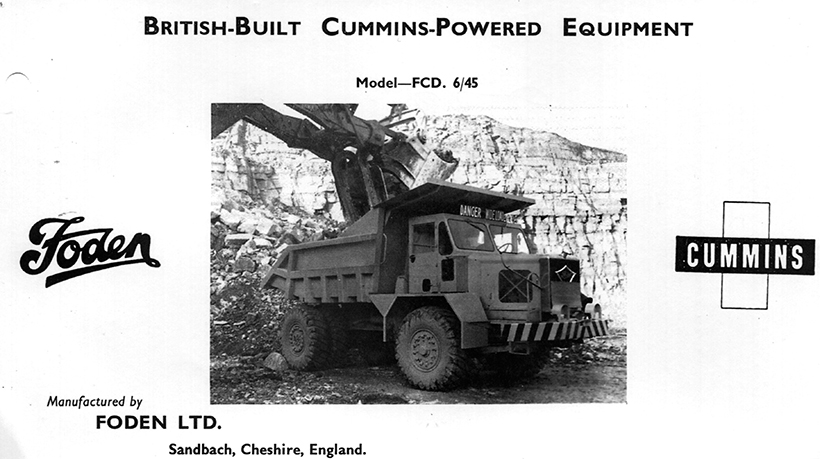
The Aveling-Barford and forthcoming giant Dumptruk, plus of course the ever-present Euclid, were about to make life very difficult for Foden. True, all four firms had strong construction industry and quarrying bases, but both Aveling-Barford and Euclid offered full ranges of plant and had specialist field back-up. The nearest Foden’s product range came were some mobile crane chassis which had been rationalised in 1958 for four to twenty-ton cranes on FC14, 16 or 20 three-axle chassis (the figures indicating inches of frame depth). All had lockable suspension on the front axle and rear springs replaced by cast steel rocker beams. These vehicles had half-cabs, or one-man cabs on either side of the boom, until Lowline cabs ahead of the front axle arrived in the early 1960s, when a four-axle model for cranes of thirty tons lift was listed.
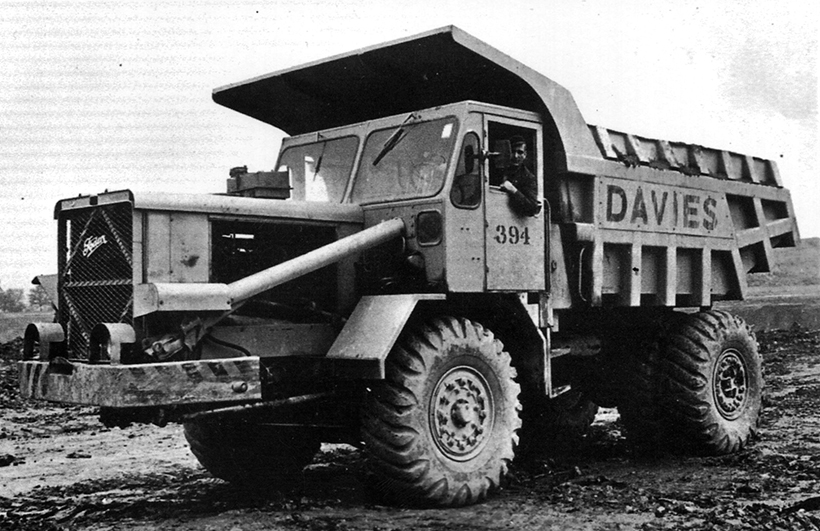
The contemporary Dutch transport historian, Piet Olyslager, wrote in the late 1960s that Foden could only make one FR 6/45 per month and abandoned production after twenty months. This is borne out by the Stone & Cox motor specifications publisher which has no mention of what it called the Giant Dumper after 1960. If there really were only twenty of them, it’s odd that I encountered seven of them – or maybe the original four had moved site and one had broken down and become a spares donor.
The same ironstone strip also used Rolls-Royce powered Vickers bulldozers, incidentally.
As early as September 1959, Cummins had issued a brochure for what it called the FCD 6/45 with NRTO-6-B diesel built at its British plant at Shotts, Lanarkshire, Scotland (which, of course, also supplied Euclid – as did Rolls-Royce).
In 1960, Rolls-Royce referred to both C6TFL and C8TFL versions of the Foden, the latter with a considerably longer bonnet. This larger engine was also used by the giant Aveling-Barford SN which, of course, put the two rivals into headlong conflict and didn’t really help in their fight with British Euclid which, by then, made two-axle machines for 45 ton loads.
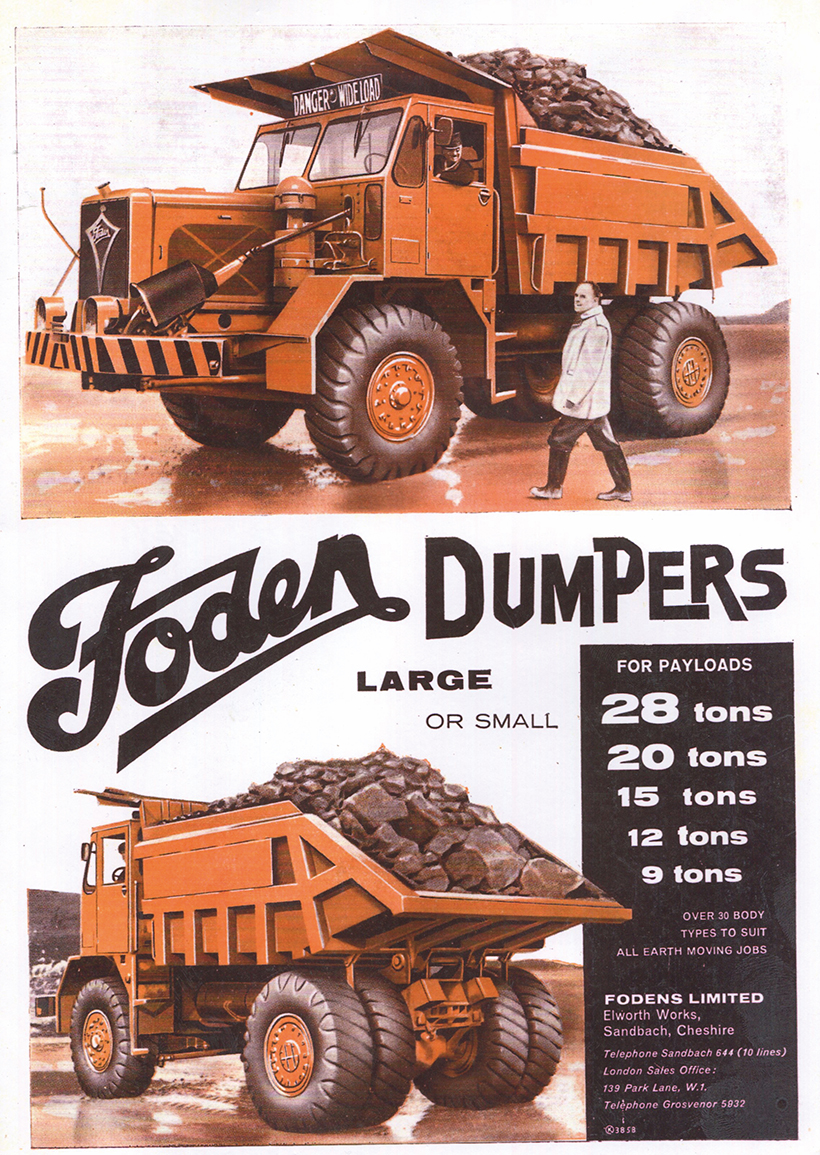
Little further reference to the big Foden can be found after an early 1961 advertisement. Certainly, by the mid-1960s, the firm had greatly simplified its range and referred only to 21 ton gross four-wheelers and 35 ton gross six-wheelers able to carry 13.5 and 22 tons respectively, powered by diesels up to a 240bhp Cummins.
However, this was not quite the end of Foden’s interest in giant dumptrucks because, in 1973, it became sole concessionaire in the UK and Eire for the German-made Faun dumptruck range. This included the Deutz-powered K22 and K25 (their payloads in short tons) which were 4×2 or 4×4 230 and 340bhp machines. Above them came the K30 4×2 or 4×4 with 405bhp Cummins or 450bhp Deutz. Next in line was the 4×2 470bhp Deutz or Cummins K40, and finally the 4×2 K80 with 755bhp Cummins or 910bhp Maybach engines. Later came a Cummins 1,050bhp hundred-tonner which, even then, was smaller than machines available in North America.
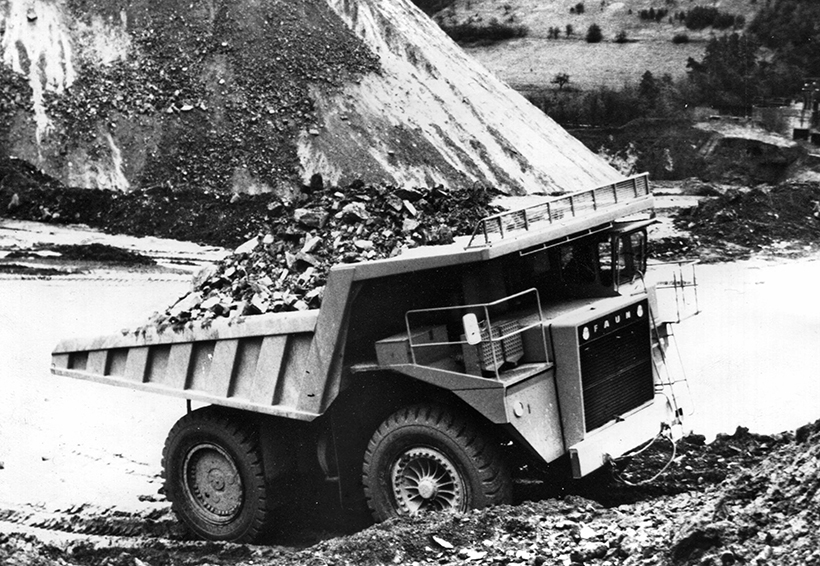
One can only assume that sales of the Fauns were no more encouraging than for the Foden FC 6/45, as little was heard of the tie-up after an early flourish of activity.
This, of course, left only Aveling-Barford and Euclid battling it out and we’ll have a look at the former’s SN model next time. Foden came close to takeover by Rolls-Royce in 1977, which might have led to a very different story as, by then, its once-successful dumptrucks had dwindled to nothing in the face of intense competition from the new breed of ADTs.
For a money-saving subscription to Old Glory magazine, simply click here

